TikTok UGC: How Brands Use TikTok User-Generated Content (Guide)
From boosting organic reach to scaling Spark Ads, brands are all-in on TikTok UGC. We dig into the benefits of TikTok using user-generated content...
Ready to ramp up your UGC ads? Below we share expert answers to the most common questions brands ask us about user-generated content advertising.
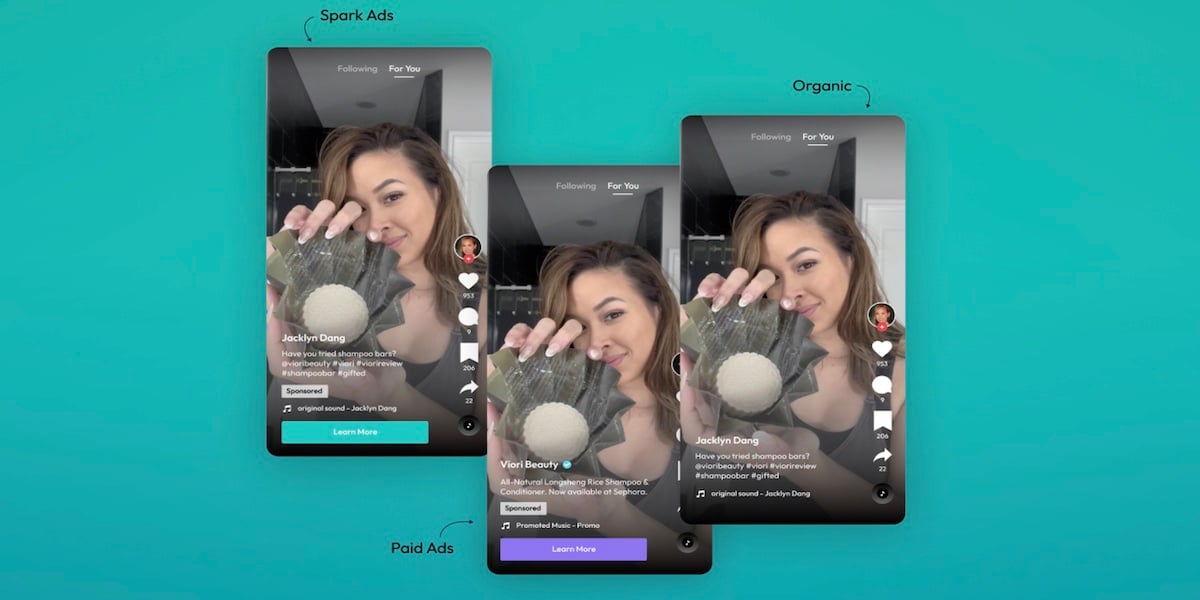

Real talk: my inbox is overflowing with questions about UGC ads from brands.
And given how fast social media trends evolve, I understand why!
But whether you call it UGC advertising, allowlisting or whitelisting, the concept is the same:
Taking authentic creator content and transforming it into high-performing paid social ads.
If you’re looking for insights and best practices to do exactly that, we have you covered. I recently hosted a panel featuring marketers with firsthand experience with UGC ads:

You can watch the full panel here!
Skip to Section 👇 |
Our hour-long conversation got into the nitty gritty of using UGC in ads. Below we’ve compiled the top questions we got from attendees with expert answers from our panel.
Whether you’re new to UGC ads or you’re ready to ramp things up, the Q&A below can help!
UGC ads are everywhere for a reason. Their effectiveness is super well-documented.
But with so many ad channels available today, marketers are right to be picky.
To kick things off, we’ll recap the benefits of UGC ads and why they’re such a priority.
Word-of-mouth is (and always will be!) the most trustworthy marketing channel.
In a sea of so-so static ads, authentic videos from real people are powerful. The enthusiasm of your satisfied customers is hard to fake and consumers can see through it if you try to.
Sinead: “Your customers are your biggest advocates and your biggest word-of-mouth marketing tool in the world. [UGC is] about the content and recommendations produced by those vocal advocates for your brand.”
Also, UGC advertising is notable for its effectiveness throughout the funnel.
For example, Spark Ads on TikTok can serve as an introduction to your brand or the last touchpoint that wins over someone who’s been on the fence. Given that 70% of TikTokers make an impulse purchase at least once per month, first impressions definitely count.
Whether someone is seeing your product in action for the first or twelfth time, you’re making a more powerful impression through authentic content.
Beyond the effectiveness of UGC ads themselves, the actual process of running them can be a treasure trove of marketing data for brands.
Case in point, consider Instagram whitelisting (AKA allowlisting) where brands run ads using a creator’s @handle. One of the key benefits of Meta’s ad platform is the ability to create lookalike audiences using creators’ actual profile data.
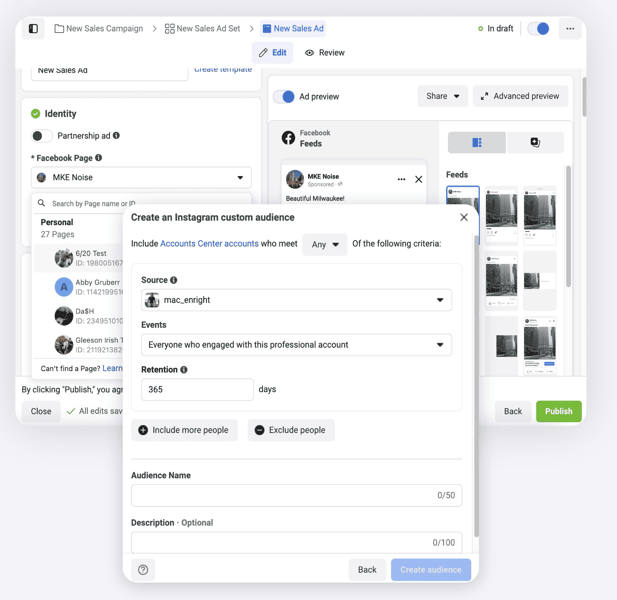
Lookalike audiences are the holy grail of ad targeting, allowing brands to run hyper-focused campaigns that require less second-guessing or optimization to be effective.
Constantly fine-tuning captions and making new ad creatives is exhausting. Not to mention a time-sink. This is especially true if you want to run more than a handful of offers at once.
On the flip side, repurposing user-generated content as ads results in massive time and resources saved. Bonus points if you can get content usage rights via allowlisting to make the process almost instant.
Beyond the convenience of speed and scalability, being able to make UGC ads quickly and at scale means that brands can run rapid-fire tests to optimize future campaigns faster.
Chase: “What is undeniably true for us is that UGC has allowed us to scale [ads]. It’s that ability to add more into the equation . . . To run more creatives and try new things. We would not be able to move as aggressively if we didn’t have as much UGC."
Based on our experience with brands, user-generated content tends to outshine in-house creatives across the board. Engagement, reach, you name it.
We’ve had a front-row seat to the evolution of social ads as they’ve shifted from polished productions to unfiltered videos over the years.
Don’t just take our word for it, though.
Meta and TikTok are adamant that creator-based ads outperform non-creator promotions. Both platforms consistently share data that reinforces the value of UGC advertising:
However, it’s not always a case of either-or between UGC ads and in-house creatives.
Brands like VIORI have seen success with a hybrid ad strategy of influencer ads generated by Statusphere’s software coupled with in-house creatives.
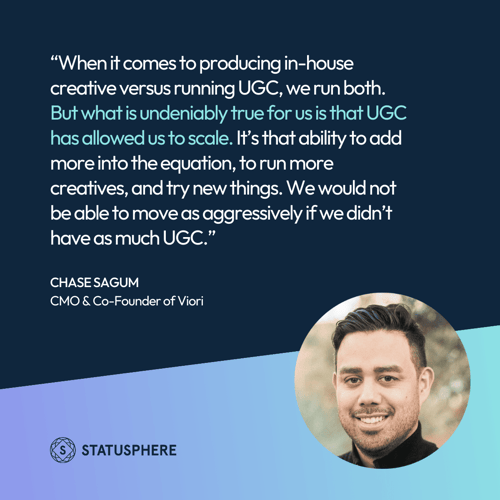
Rather than pit the UGC and in-house creatives totally against each other, consider that they can work in tandem. Meta notes that Partnership Ads with traditional, non-creator ads result in 53% higher click-through rates and 19% lower cost-per-action.
In terms of UGC ad effectiveness, remember that modern consumers want to see promoted products in the hands of real people. Recent research from Meta notes that “perfection fatigue” is hurting brands running ads that feel too polished and produced.
Sinead: “People are tired of the over-polished, picture-perfect flat lay. Show me how you use it [your product]. Show me how it works. It doesn’t have to be perfect. It’s the actual real-life look into how to use a product that drives people.”
For reference, take a peek at the top-performing Spark Ads on TikTok at any given moment. Note how they’re all raw, off-the-cuff and anything but pristine. This highlights why UGC creators are in such high demand among brands running ads.
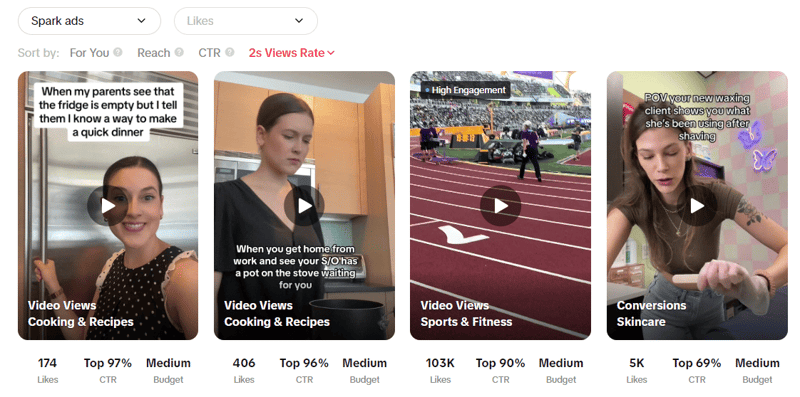
UGC ads are proven performance-wise and require less work to set up and create versus non-creator ads. That said, brands shouldn’t ignore low-hanging opportunities to optimize and improve their promotions.
Chase: “When an ad creative works, in our case, it tends to fatigue a little bit quicker than we’d like. We’ll see a really good UGC video perform extremely well for like 30 to 60 days before it starts to fizzle out. We’ve built a system around that to just keep feeding it and keep UGC coming in."
Performance decay is frustrating but it’s a phenomenon that plagues most social lads. With TikTok especially, you can’t run the same ad set forever and expect ongoing results.
This is exactly what Chase means when he talks about “feeding” the system new content to keep ad performance strong. To date, VIORI has generated 800+ pieces of rights-ready UGC with Statusphere’s platform to help fuel their content engine.
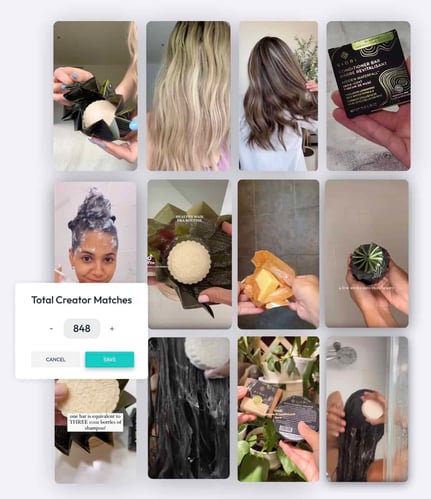
Piggybacking on Chase’s point above, cycling through fresh creatives is crucial for the sake of staying top of mind without boring your target audience.
Because serving the same handful of ads is a recipe for so-so results.
Austin: “We always say it takes seven touchpoints for a brand to make a great impression on a consumer. If you just hit them with the same content over and over again, it may ‘count’ as fourteen ads. But it was really only two impressions you made. It’s that volume and variety that you really want. People have different perspectives and experiences.”
Translation? UGC advertising is anything but a one-size-fits-all affair. Brands should embrace variation and experimenting when it comes to:
This highlights the benefits of working with a high volume of creators and not forcing them to stick to a script. Having dozens of potential ad creatives on deck also means more opportunities to learn and further refine your UGC ads.
Chase: “At any given time, we’re testing between 30 and 40 different creatives inside our ad accounts. We’re constantly weeding through, finding winners and adding budget to those winners. When we find winning creatives, we turn those learnings into advice and feedback for other creators we’re working with.”
Sinead: “I always say ‘Fill that funnel.’ Keep making that funnel be your microphone.
It’s gotta constantly be talking and echoing out into the world.
If you have an always-on UGC strategy, you can take pieces all the time and weave [them] into your ads year-round."
Achieving an always-on strategy with influencers or UGC can be a mental hurdle for marketers who imagine doing all of the legwork themselves.
The key is to build that scalable content engine we mentioned earlier. Doing so is easier with a micro-influencer platform that can activate hundreds of smaller creators in a fraction of the time it’d take DIY.
We’ll bite: UGC advertising isn’t 100% foolproof. While creator-based ads have a track record of positive results, they still require a strategy.
Below is a breakdown of the most common UGC ad mistakes according to Sinead:
That last point is a big one. Maximizing your investment in UGC means squeezing as much as you possibly out of your content. This happens through strategic repurposing.
Sinead: “Once you find those pieces of UGC that just crushed it, take them and leverage them elsewhere. Don’t just think that these pieces of content have to live in an ad. They really don’t. Maximize your investment!”

Sinead also makes a crucial point about getting the green light to repurpose, though:
“Please make sure that you have permission to do that. Do NOT steal content and leverage it in other areas.”
Getting creator permission is an integral piece of UGC advertising that becomes a time-sink as you scale content. That’s why usage rights should be baked into your influencer agreement. Better yet, consider how a UGC platform can help you obtain them automatically.
When it comes to creative direction, less is almost always more.
UGC advertising isn’t 100% hands-off. Still, we’ve found that the brands that earn the best content for UGC ads aren’t afraid of giving creators freedom and room to breathe.
There’s a big difference between providing directions and inspiration versus trying to art-direct every piece of content.
Finding that balance is a win-win for brands and creators alike. For brands, it means less legwork and stress. For creators, it means more opportunities to get creative and make the sort of content that their audiences love without needless restraints.
For example, Chase’s directions for VIORI’s content creators are framed as a set of recommendations to work within. But at the end of the day, he acknowledges that creators know should take the wheel:
Chase: “I try to make it very clear that . . . I want the creator to try something crazy if they feel so inclined. I think that’s very important. I’m never gonna pretend to know more than the creator does, particularly for his or her audience.”
Austin puts it best when it comes to why brands should trust creators’ judgment:
Austin: "Creators are essentially social media managers, creative directors, copywriters — they’re full-stack marketers. So, don’t ever box them in. Let them use their creative prowess."
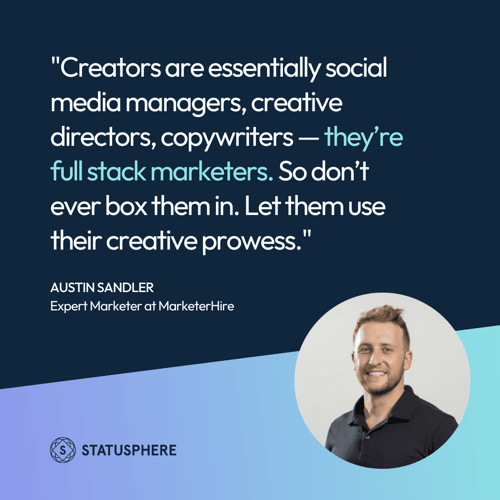
For me, one of the coolest aspects of user-generated content is that there’s no one-size-fits-all approach to promoting it. This gives brands and creators a ton of creative freedom. The end result is better content and better ads.
Hopefully this Q&A provided some much-needed insight into the evolving world of UGC ads.
But if you’re still struggling with scaling UGC ads or getting your creatives right, I get it.
The space is constantly changing. New rules, new formats. Keeping up with best practices is easier said than done when you aren’t working with creators day in and day out.
Need a hand in optimizing your UGC ad strategy? Our micro-influencer marketing platform can fuel your brand’s content engine with rights-ready UGC at scale.
We’ve already helped 400+ brands generate 75,000+ pieces of content and our new allowlisting features mean that our brands can ramp up UGC ads even faster than ever.
Want to see how our platform makes it all happen? Get in touch with one of our influencer specialists to see how we can help you scale content in a fraction of the time.

From boosting organic reach to scaling Spark Ads, brands are all-in on TikTok UGC. We dig into the benefits of TikTok using user-generated content...
Missed TikTok World? Here's the recap, including TikTok Shopping updates, new Creator Marketplace features and more.
Want to future-proof your social ad campaigns? We have new insights from Meta to help marketers lower customer acquisition costs despite privacy...
Be the first to know about the latest tools, trends and strategies in influencer marketing for brands.